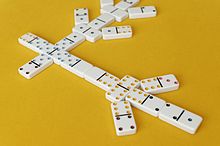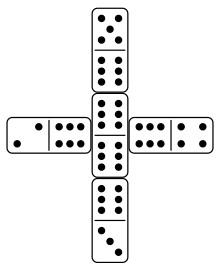
Chinese dominoes are used in several tile-based games, namely, tien gow, pai gow, tiu u and kap tai shap. In Cantonese they are called gwāt pái (骨牌), which literally means "bone tiles"; it is also the name of a northern Chinese game, where the rules are quite different from the southern Chinese version of tien gow.

Dominoes is a family of tile-based games played with gaming pieces. Each domino is a rectangular tile, usually with a line dividing its face into two square ends. Each end is marked with a number of spots or is blank. The backs of the tiles in a set are indistinguishable, either blank or having some common design. The gaming pieces make up a domino set, sometimes called a deck or pack. The traditional European domino set consists of 28 tiles, also known as pieces, bones, rocks, stones, men, cards or just dominoes, featuring all combinations of spot counts between zero and six. A domino set is a generic gaming device, similar to playing cards or dice, in that a variety of games can be played with a set. Another form of entertainment using domino pieces is the practice of domino toppling.
Tien Gow or Tin Kau is the name of Chinese gambling games played with either a pair of dice or a set of 32 Chinese dominoes. In these games, Heaven is the top rank of the civil suit, while Nine is the top rank of the military suit. The civil suit was originally called the Chinese (華) suit while the military suit was called the barbarian (夷) suit but this was changed during the Qing dynasty to avoid offending the ruling Manchus. The highly idiosyncratic and culture-specific suit-system of these games is likely the conceptual origin of suits, an idea that later is used for playing cards. Play is counter-clockwise.

Triominoes is a variant of dominoes using triangular tiles published in 1965. A popular version of this game is marketed as Tri-Ominos by the Pressman Toy Corp.

Shut the box is a game of dice for one or more players, commonly played in a group of two to four for stakes. Traditionally, a counting box is used with tiles numbered 1 to 9 where each can be covered with a hinged or sliding mechanism, though the game can be played with only a pair of dice, pen, and paper. Variations exist where the box has 10 or 12 tiles.
The Black Path Game is a two-player board game described and analysed in Winning Ways for your Mathematical Plays. It was invented by Larry Black in 1960.

Rummy is a group of games related by the feature of matching cards of the same rank or sequence and same suit. The basic goal in any form of rummy is to build melds which can be either sets or runs and either be first to go out or to amass more points than the opposition.

42, also known as Texas 42, is a trick-taking game played with a standard set of double six dominoes. 42 is often referred to as the "national game of Texas". Tournaments are held in many towns, and the State Championship tournament is held annually in Hallettsville, Texas on the first Saturday of March each year. In 2011 it was designated the official State Domino Game of Texas.
Speed is a game for two players of the shedding family of card games, in which players try to get rid of all of their cards first. It is a form of competitive patience similar to Spit.

Domino, also known as Card Dominoes, Spoof, Sevens, Fan Tan (US) or Parliament (UK), is a card game of the Layout Group of matching card games for 3–8 players in which players aim to shed cards by matching the preceding ones or, if unable, must draw from the stock. Cards are played out to form a layout of sequences going up and down in suit from the agreed starting card. The game is won by the player who is first to empty their hand. The game is a cross between dominoes and patience and is suitable for children who have learnt the various card values.

Barbu, also known as Tafferan, is a trick-taking, compendium card game similar to hearts, in which four players take turns leading seven different sub-games over the course of 28 deals. Barbu originated in France in the early 20th century where it was especially popular with university students, and became a prominent game among French bridge players in the 1960s. The French version of the game was originally played with a stripped deck of 32 cards ranked seven to ace in each suit. Modern forms are played with a full 52-card deck. Barbu may be descended from earlier compendium games popular with students and originating in the Austro-Hungarian Empire such as Lorum or Quodlibet.

Muggins, sometimes also called All Fives, is a domino game played with any of the commonly available sets. Although suitable for up to four players, Muggins is described by John McLeod as "a good, quick two player game".

Matador or Matadore, sometimes called Russian Dominoes, is a domino game for two to four players using a double six set of dominoes. It is one of the blocking family of domino games in which the object of the game is to be the first to go out, while blocking one's opponents from doing so. Its distinguishing feature is the unusual rule of playing tiles so as to combine pips instead of matching numbers.

Mexican Train is a game played with dominoes. The object of the game is for a player to play all the tiles from his or her hand onto one or more chains, or trains, emanating from a central hub or "station". The game's most popular name comes from a special optional train that belongs to all players. However, the game can be played without the Mexican train; such variants are generally called "private trains" or "domino trains". It is related to the game Chicken Foot.

Bendomino is a tabletop strategy game similar to dominoes, created by Thierry Denoual and published by Blue Orange Games in 2007. It is a set of double-6 dominoes with a 120-degree curve. The main difference from dominoes is the curved shape of the pieces, which introduces a new level of strategy to the game. There is also a version of the game for younger players with pictures instead of numbers and symbols on the Bendomino tiles.
Kiu kiu or qiu qiu is a game of dominoes popular in Indonesia related to pai gow. It may also be referred to as 99 domino poker.

Zwanzigerrufen or Zwanz'gerrufen is the leading trick-taking card game of the Tarock family in many regions of eastern Austria. Its rules are simpler than the game of Königrufen which is more widely played in the whole of Austria. As is common in Tarock games, the cards have various point values – the primary goal in an individual game is to win the majority of points.

The following is a glossary of terms used in dominoes. Besides the terms listed here, there are numerous regional or local slang terms. Terms in this glossary should not be game-specific, i.e. specific to one particular version of dominoes, but apply to a wide range of domino games. For glossaries that relate primarily to one game or family of similar games, see the relevant article.

Contack is a dominoes-like game for one to seven players which was patented by Parker Brothers and published in 1939. It uses 36 equilateral triangle tiles; each side is assigned a different color and numerical value. Players take turns laying tiles from a hand of five next to tiles already on the table; newly-laid tiles must match the color of adjacent tile(s).


















